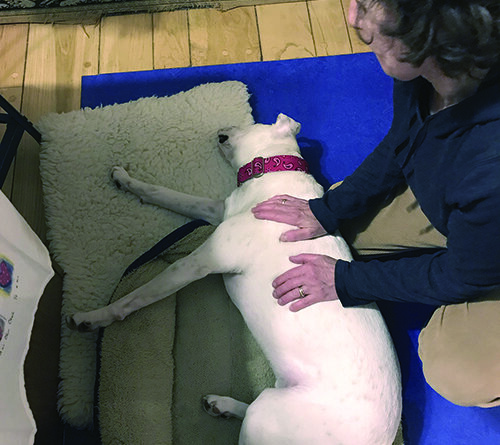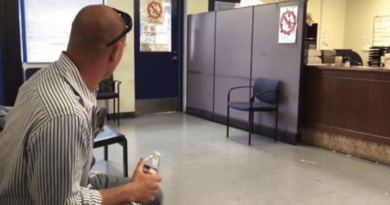Canine Massage Therapy – Whole Dog Journal
As a newly board-certified canine massage practitioner, I want to encourage everyone who is dedicated to their dogs to consider adding professional massage to their dogs’ healthcare plan. Who needs this? I would suggest every dog. For some dogs, it is essential; for the rest, it will enhance their lives, at a minimum. How so?
- Let’s start with young, healthy dogs like my Peter. Practicing massage on him, starting just a few months after my husband and I adopted him, clearly enhanced our bond. I started slowly and found that he enjoyed every stroke and was happy to have me (and my classmates) touch him everywhere. Also, maintenance massage can assist in protecting the bodies of young, athletic dogs from injury and build resiliency.
- For newly adopted dogs, particularly those who have had a rough start in life, gentle massage will help relax your dog and allow you to touch him when you need to for other reasons. Just start gently and in areas where the typical dog has fewer worries (e.g., shoulders, base of neck). This has helped me greatly with trimming Peter’s nails.
- Several of my fellow students spent their internships in shelters. They reported in words and video how powerful massage is at helping stressed dogs become more relaxed and trusting of humans.
- For senior dogs, massage will help to identify areas of soreness and bring some relief. Massage also seems to help older dogs suffering from cognitive dysfunction; maybe it’s just from having their circulation improved and their neural circuits stimulated by novel touch!
- For dogs who have had injuries, massage – with the express direction and approval of their veterinarians – can help reduce the formation of scar tissue, soften and lengthen tissue to assist healing, and increase flexibility. It can also help loosen muscles that may be compensating, so more injury does not result. Massage can reduce tightness in areas where dogs have restrictions. Gentle, directed, firm bodywork can stimulate the release of endorphins, with a powerful pain-relieving effect.
- Dogs with respiratory conditions may benefit from massage by relaxing and strengthening the rib muscles that support lung function.
Does this all sound familiar? If you have been treated with massage, you may recognize many of these benefits.
WHY AND HOW TO HIRE A PROFESSIONAL
While almost anyone can learn to use some basic massage strokes to relax their dog, a well-educated practitioner can use more specialized massage techniques to effectively address the particular issues that affect your dog.
Massage is one of the modalities that is often considered as a “can’t hurt” practice, but it can be contraindicated. Dogs with certain cancers (e.g., mast cell cancer and osteosarcoma) should not be massaged, and dogs with spinal injuries require special consideration. Dogs who are sick with fever, suffered a recent trauma, or “just aren’t right” should see a veterinarian before massage.
Be aware that there is no consistency in the U.S. regarding the regulation of animal massage. The website of the International Association of Animal Massage and Bodywork (IAAMB) lists the laws pertaining to animal massage in each state: iaamb.org/resources/laws-by-state.
If you are looking for a prospective massage therapist for your dog, I recommend looking for credentialed professionals. I’m biased, because I recently was certified by the National Board Certification of Animal Acupressure and Massage (NBCAAM), which requires a minimum of 50 hours studying anatomy and physiology, 50 hours of supervised hands-on work, and 100 hours of study in other areas (including business ethics, animal behavior, and biosecurity). NBCAAM reviews the education and experience of candidates to ensure adequacy and then administers a board examination. I believe this sort of rigorous credentialing process is a must.
Some veterinary offices and veterinary rehabilitation centers employ technicians who are trained in massage. Even so, I would check the practitioner’s credentials. Was their training program at least 200 hours, and did it include anatomy and hands-on training? There are any number of one-week and video educational programs out there, which are not adequate (in my opinion) to qualify someone to work on my dog! If you feel the same, investigate those credentials!
If you have any uncertainty about the practitioner’s qualifications, ask for references – and check them! Also, if your dog has a specific issue that needs to be addressed, ask the practitioner if she has had experience addressing that issue.
WHAT TO EXPECT
Before the massage practitioner ever touches your dog, she should have you complete an intake form about your dog. It should have room to include information about any physical and behavioral issues your dog has. The practitioner should then spend time reviewing this information with you. If there is an active illness or physical problem, she should consult with your veterinarian before working on your dog.
You should absolutely be permitted to be present when the practitioner works on your dog; in many cases, the practitioner will prefer this, as your dog may be more relaxed with you in the room. Massage may take place in your home or in the practitioner’s office, which should be clean and soothing.
The practitioner may employ a dog appeasing pheromone like the Adaptil (DAP) plug-in; there may be calming music such as “Through a Dog’s Ear” playing, and there should be a freshly covered soft cushion for your dog. I prefer to work on the floor because I think it’s safer and more comfortable for most dogs. But for small dogs, some practitioners may opt for a table. Massage can make dogs thirsty, so fresh water should be available.
Some dogs may enjoy chomping on a Kong or other chew while getting massaged, and the practitioner might offer your dog an occasional treat for staying calm and relaxed. If your dog tends to guard his chews or treats, let the practitioner know so she does not offer him something to chew.
If your dog is shy or anxious with strangers, the first session may mean just getting used to the practitioner and limited touching. It may take a few sessions until the dog is willing to lay still and allow the full extent of the work.
The practitioner should be very mindful of your dog’s body language and never insist on working on an area that the dog has expressed is a no-go. Massage should not be forced – dogs should be allowed to get up and move and come back as their choice. Often, dogs who are not comfortable with being touched in certain areas may, over time, allow massage in those places.
The length of the session will depend to some extent on your dog’s reaction. If the dog is quite accepting, this will allow the bodyworker to move from the warming-up strokes (such as effleurage and compression) to deeper techniques (such as petrissage and direct pressure), and to more areas of the body.
The practitioner may use any of a variety of techniques for your dog’s massage. Swedish massage is excellent for warming up the dog’s tissue for deeper strokes and handling most minor muscle problems. Swedish strokes combine compression with gliding, lifting tissue, squeezing, or vibration, depending on the effect desired.
Trigger-point therapy softens up “knots” in the muscle, often using direct pressure. Myofascial release uses gentle pressure to affect change in the tissue that surrounds muscle. Passive range-of-motion exercises can be very effective to enhance joint flexibility and range.
Some practitioners augment massage with other modalities, such as Tui Na (Chinese massage), kinesiology taping, and acupressure.
Toward the end of the session, the practitioner may also employ some passage range-of-motion exercises. The practitioner will support a joint on both sides and move the limb through its comfortable range of motion and within its proper plane, without forcing. In addition, the practitioner may show you ways to encourage your dog to stretch using treats. These may include neck stretches where the dog follows the treat from side to side, toward either shoulder, or encouraging a bow.
At the end of the session, the practitioner should provide you with her findings, including pointing out any problem areas, growths, or lumps that should be mentioned to your dog’s veterinarian. She may also make suggestions about future sessions.
I love massaging my dog as well as other people’s dogs. I walk away from every session feeling positively uplifted and more connected to my canine friends. The happy comments I receive from the dog owners are icing on the cake.
Massage has the power to transform your dog’s life and even your own. I recommend that you learn more about massage and its benefits and consider a session for your dog.






buying from online mexican pharmacy https://mexicanpharmacy.company/# mexico drug stores pharmacies mexicanpharmacy.company